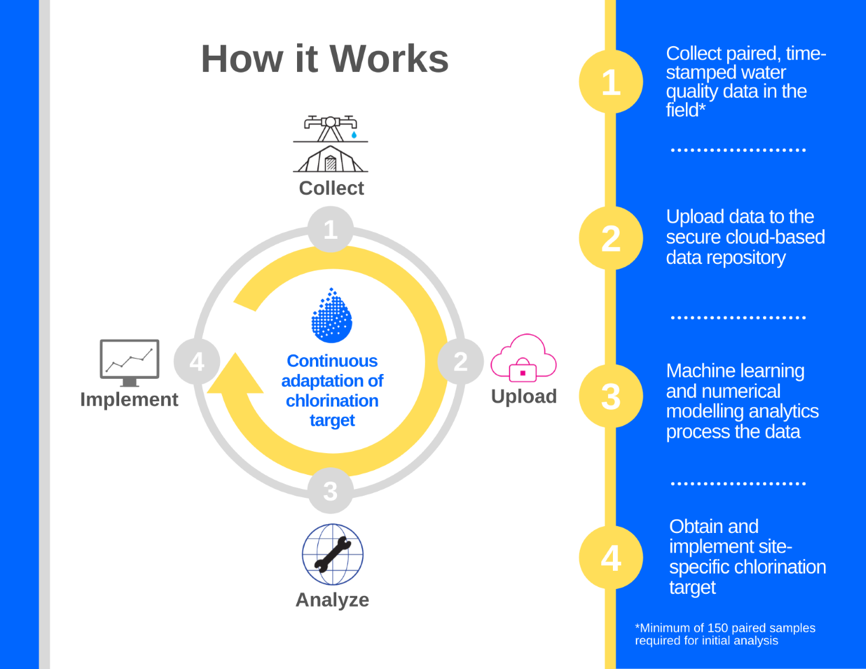The Safe Water Optimization Tool (SWOT), which launched on November 5, is the first web-based tool of its kind, and can be used in locations such as refugee camps to ensure water is safe for consumption. This tool’s purpose is to improve global health by detecting whether the drinking water is safe or unsafe, reducing instances of waterborne diseases.
The SWOT calculates the chlorination in water to determine its safety for human consumption by analyzing the free residual chlorine (FRC) in the drinking water. The SWOT measures the FRC data in water at the point of distribution and the FRC data hours after being collected to determine if it is still safe for consumption.
Research fellow, founder, and lead of SWOT, Syed Imran Ali PhD, explains that this tool’s origin extends back to 2013 while conducting research in South Sudan alongside Doctors Without Borders (MSF) and observing a waterborne outbreak of Hepatitis E.
“At the same time we were working on ensuring that the water we delivered to people was safe. And when I say safe, I mean it was free of pathogens. So as we’re working on the water quality issue we were using water treatment guidelines that are universally used in the humanitarian sector called the Sphere Project.”
“For water supply it tells us how we should chlorinate water,” Ali continues. “How much chlorine needs to be added to the water to disinfect it first, and then to remain in the water so that any pathogens that come through the water, the chlorine will kill them.”
“Chlorination is the only water treatment method that’s widely used at least, that offers residual protection, which is super important in a refugee camp. We were implementing these targets for chlorination at the distribution points, but when we went to people’s homes and tested the water there, very often we saw the water had no chlorine residual protection — it was unprotected.”
“People’s habits of storing and (re)using water in camps are very different than people consuming water in cities do. It is very hard to determine whether water in these camps will be safe using conventional approaches.”
The conclusion drawn, which emphasised a need for a tool such as SWOT, was that these universal guidelines ultimately differ in certain spaces, as seen in these refugee camps. This is the importance of SWOT being site-specific rather than universal, Ali explains, stating that, “SWOT basically emerged in response to this problem. We need to have site-specific and evidence based water treatment guidelines, and that’s what the SWOT enables us to do.”
Usman Khan, Phd, PEng, assistant professor and graduate program director and Artificial Neural Network lead (ANN) for SWOT, explains how this web-based tool is crucial as a result of the rising number of both refugee camps and internally displaced persons camps in recent years.
“People’s habits of storing and (re)using water in camps are very different than people consuming water in cities do. It is very hard to determine whether water in these camps will be safe using conventional approaches. ANNs provide an alternative, data-based approach to predict water safety in refugee camps in a way that current, existing methods cannot.
“Thus, the overall global opportunity the SWOT provides is to ensure clean and safe water for people living in refugee or internally displaced camps. Given the number of people living in these camps, and the need to ensure their safety and well-being, the SWOT is a powerful tool.”
When looking to the future, Khan sees growth for this tool both globally and locally.
“We would like the SWOT to be used by agencies across the world, and adapted to different settings (e.g. outside of refugee camps). Locally, there are opportunities to adapt the SWOT for remote communities in Canada, and for emergency settings (e.g. during floods, fires, earthquakes) where access to water supply may be disrupted.”
“Our vision is for this to become standard practise in the humanitarian sector,” explains Ali when asked about the future of SWOT, “so any time people are delivering water supply to refugee camps, they should be using this tool to take advantage of the data they’re already collecting. We’d like to see it become part of routine operations.”
SWOT will be conducting a virtual launch event on November 25.


